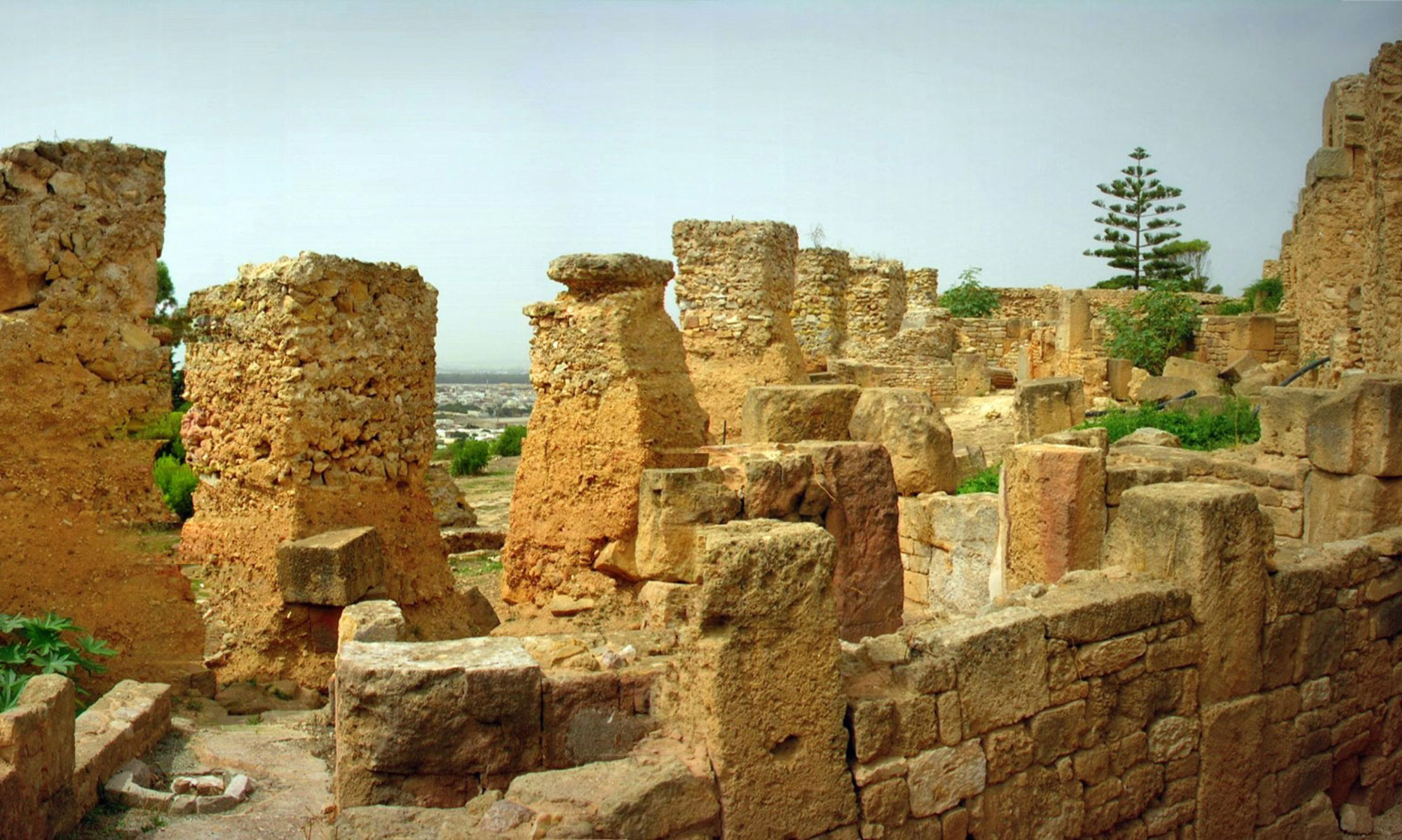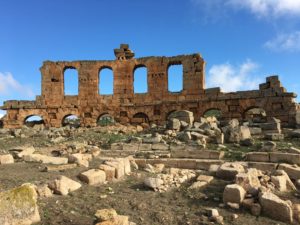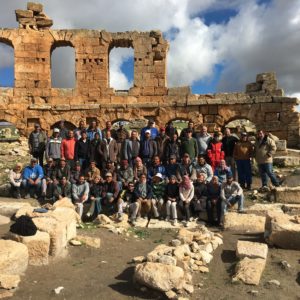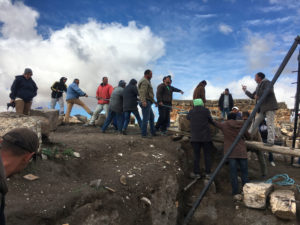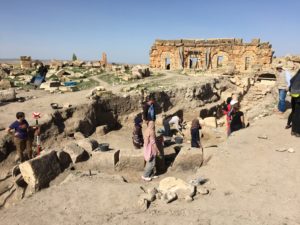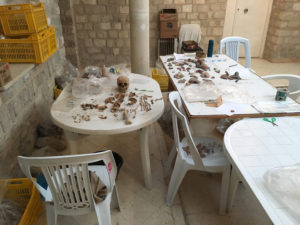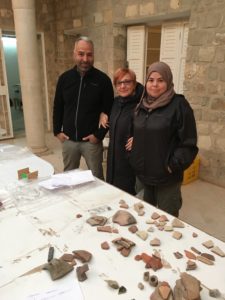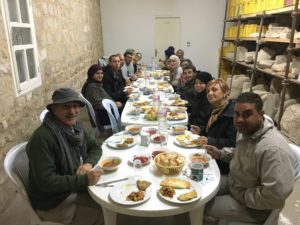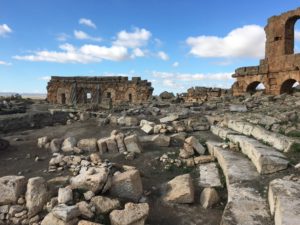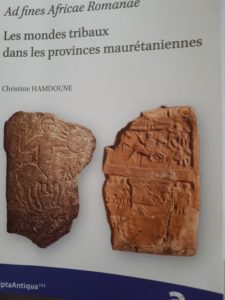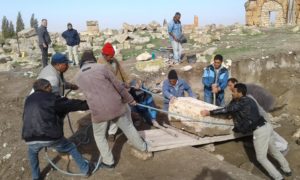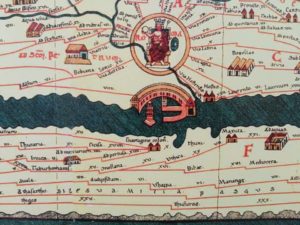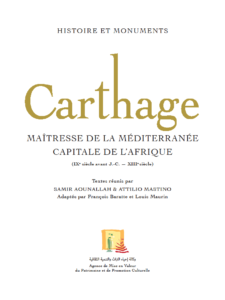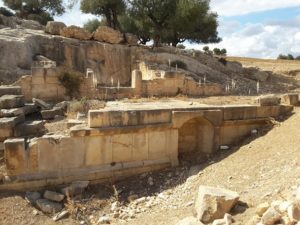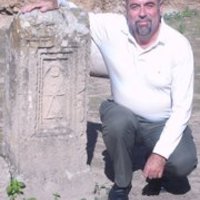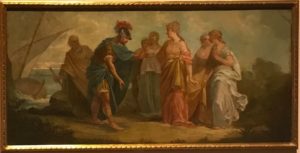
The study that has been undertaken over the last thirty years of the historical relations between North Africa and Europe in antiquity is far-ranging and rich in results. The areas studied include the pre- and proto-historic phases of the Berber world, the colonisation by the Phoenicians, the foundation of Utica and Carthage, the Mediterranean politics documented by the Etruscan-Carthaginian and Roman-Carthaginian treaties, also dealing with Hannibal and the rather hypocritical tears of Scipio Aemilianus, as well as the new urbanisation by order of Gaius Gracchus, then by Caesar and Augustus twenty years after the re-foundation of Carthage. Virgil in Book I of the Aeneid describes the builders of Dido’s Carthage as being like thousands of bees in a hive at the start of summer, toiling to produce honey with a scent of thyme: it is clear that Virgil was thinking of the Augustinian colony as it was in the years in which he was writing, a Mediterranean capital rich in products coming from the wide Numidian hinterland.
In the fervour of the structores Tyrii of Carthago, the refugee from Troy, Aeneas is both hospes welcomed with respect by the queen and then hostis who is cursed for centuries: he observes, through Virgil’s eyes, the furrow of the plough as it marks the sacred limit of the colonia, renewing the pain and the hope that motivate those who build a new city, in contrast with his original hometown, Ilium, that was devoured by the flames. There is no doubt that Virgil reflects the urbanistic experience of the Augustinian Age in Africa in his description of the birth of Carthage with the theatrum of the immanes columnae of the frons scaenae taken from quarries in which the specialised workers laboured untiringly to extract the stone to build the new city. Or yet again the portae of the walls and the strata viarum, the urban viae silice stratae, the judiciary basilica and the theatre. Virgil’s lines exalt the activity of the men of goodwill, even though the gods and goddesses are fully involved in a studium and in an ars that nobilitates those who practice it.
More in general, Virgil found the words to represent the landscape that had been transformed by man at the side of the lake of Tunis, close to the temple of Juno, which had been built by the queen, the place where a magical finding of a horse’s skull had been announced by the oracle. In fact, how can we forget the Virgilian hyperbole of Meliboeus in the first Eclogue, At nos hinc alii sitientes ibimus Afros? And then the Vandals, the Justinian reconquest, and the Byzantine organisation up to the opening up (futûhât) to Islam. There have been many occasions, on both sides of the Mediterranean to discuss and compare notes regarding an archaeological and historiographical record that is able to go straight to the heart of the ancient world, overcoming the ideological deformation of our times. I take the opportunity to mention the many great international projects that have been and are being undertaken: the patronage of UNESCO for the site of Carthage from 16th October 1979; the Africa Romana conferences, which have been organised on an annual basis by the University of Sassari, as well as those of Tunis, Carthage, Djerba and Tozeur, which allow archaeologists, historians, and epigraphists to present their findings, with the aim of identifying the regional and national contributions to the phenomenon of Romanisation, as well as to highlight the relations between the dynamic and open Mediterranean area. The next appointment is in Tunis, in December 2018, for the 21st L’Africa Romana conference, the title of which is “Latin Epigraphy in North Africa: New discoveries, Re-interpretations, New synopses”.
On an international level, the topic facing us today is wider, one that goes far beyond the direct relations between the two shores of the Mediterranean: in a new interpretation, Africa becomes an essential part of the Mediterranean basin, a coastal area that is not isolated, but is instead closely related with the depths of the continent (I use the words of Umberto Cardia), finding in the Mediterranean a space for contact, co-operation, and we might say, super-national integration. This is the view by way of which we would like to build a different future; in fact we are ever aware of the need to show the greatest respect for cultural and religious traditions, for the profoundness of the different histories and different cultures, and for the cultural heritage with the awareness that there are geographical and chronological variables at play in the moment when different cultures come into contact, while always wary of losing concreteness and using scientific data for ideological purposes. We must oppose the simplifications that do not take the complexity of history into account.
The idea of creating a Scuola archeologica italiana a Cartagine [Italian Archaeological School in Carthage] was that of Antonino Di Vita and Andrea Carandini. It was proposed in several of the L’Africa Romana conferences and during the round table entitled “Mediterraneo Antico, Italia e Tunisia, Cooperazione e Patrimonio Culturale” [The Ancient Mediterranean, Italy and Tunisia, Cooperation and Cultural Heritage], which took place in Rome on 12th April 2013, under the auspices of the INP-ISMA CNR project on the sanctuary of Baal Hammon at Althiburos; on that occasion, two years after the “Jasmine Revolution” Adnan Louhichi, Directeur Général of the Institut National du Patrimoine (INP) in Tunis pressed for a joint effort to reach the aim of presenting to the world the shared roots that unite the Mediterranean, proposing the establishment of an École Italienne de Carthage and citing on one hand, the difficult socio-political situation in contemporary Tunisia after the flight of Ben Ali on 14th January 2011 (immediately after this, Azedine Beschaouch, who had been bestowed with an ad honorem degree in Sassari, was nominated Minister for Culture in the government headed by Béji Caïd Essebsi), and on the other, the necessity to highlight, with the support of the European countries involved in the cooperation, how much of culture and most ancient history of the north-African country needed to be protected and promoted. In 2014 an Argumentaire laid out by Sergio Ribichini started to circulate; this contained the bare bones of the project, the start of the art, and the details of the future school, strongly advocated for by the then general President of the INP, Nabil Kallala. Also mentioned were the partners, its structure, and its aims and budget. These themes were at the centre of an Atelier de recherche that was held in Rome on 18th December 2014 at the CNR, presided by the President of ISMA, prof. Alessandro Naso, with the participation of important representatives of MAECI and the president of ICCROM in Roma, Stefano De Caro, along with Cinzia Vismara, and Luciano Borin (who had initiated the constitution of an“Association pour la Valorisation d’Heritage Culturel”, in Tunisia), various members of the joint CNR-INP archaeological mission at Althiburos, and many more of us. In the following months (President of the INP Fathi Bahri) the Society saw the convergence of a number of bodies, especially the Italian universities (with the two departments, History, Human Sciences and Education of the University of Sassari, and History, Heritage and Territory of the University of Cagliari in the vanguard), other foreign universities and Institutions, in particular the CNR’s Institute of the Ancient Mediterranean with Agence de Mise en Valeur du Patrimoine et de Promotion Culturelle di Tunisi (l’AMVPPC, then directed by Ridha Kacem, today by Kamel Bchini), the INP (today directed by Faouzi Mahfoudh), the Italian Ministry for Foreign Affairs and International Cooperation, the Italian Institute for Culture in Tunis, the Institute for Studies and Programmes for the Mediterranean, and the Fondazione di Sardegna [Sardinia Foundation]. Further participation was offered by the School for Specialisation in Archaeology, and museums, associations and institutions involved in the safeguarding of the archaeological heritage of the Mediterranean, in particular that of Tunisia and the Maghreb, in the fields of documentation, training and research.
The Academic Society SAIC “Scuola Archeologica Italiana di Cartagine. Documentazione, Formazione e Ricerca” [Italian Archaeological School in Carthage. Documentation, Training and Research], was established in Sassari on 22nd February 2016, by way of a notorial act at the office of the solicitor Laura Faedda, with 25 founding members.
On 10th May, the SAIC was inserted at n. 31 on the “Registro delle Persone Giuridiche” [Legal entity register] at the Prefecture of Sassari, complying with the law DPR 361 of 10th February 2000[1].
The Life of the Society
The total number of members, after approval at the last Assembly, was 154, and this figure is divided into Honorary Founding Members (25), Full Members (7), Meritorious Members (6), Honorary Members (88) and Correspondent Members (28)[2].
During the year, one of the Honorary Members, Eduardo Blasco Ferrer, a great scholar and close friend, passed away.
The Honorary Members of the SAIC are those who direct cooperation projects with Tunisia[3]. Some of these projects avail of co-financing from the Direzione Generale per la Promozione del Sistema Paese del MAECI (Settore Archeologia), [General Direction for the Promotion of the Country System of MAECI – Archaeological sector], which assists Italian archaeological, anthropological and ethnographic missions abroad, as well as providing scholarships to researchers in foreign countries.
The school is ever growing: in the framework of an effort to coordinate Italo-Tunisian archaeological projects, it witnesses burgeoning participation by scholars belonging to Italian and foreign universities and academic institutions. The Assembly has met ten times: in Rome, in Sassari, and several times in Tunis at the Italian Institute of Culture, where, in the presence of the Italian Ambassador Raimondo De Cardona and the President of the IIC Maria Vittoria Longhi, we were presented on 18th March 2016 and 17th March 2017 (fig. 4) in commemoration of the attack on the Bardo Museum, with seminars promoted by IIC Tunis, “Archaeology and protection of the heritage of Carthage: the state of the art and future possibilities for Italo-Tunisian cooperation”.
The last meeting was held on 6th October for the inauguration of the Sabatino Moscati Library, for which communication was given to the Tunisian Ambassador to Italy, Moezeddine Simnaoui.
SAIC has the aim of favouring forms of coordination between initiatives that characterise Italian cooperation in Tunisia (and in the countries of the Maghreb) in the realm of scientific and cultural studies. It also has the objective of: favouring opportunities for research, training and spreading knowledge concerning the heritage relating to prehistoric, pre-classical, classical, late-ancient, Islamic and modern civilisation; optimising the results of each initiative with functional coordination; contributing actively to intercultural dialogue and to the policies of development of Tunisia.
SAIC has the general intention of working alongside the Ministry for Foreign Affairs, and that of International Cooperation, as well as with the Italian Cultural Institutes, for the organisation and coordination of initiatives of a scientific, documentary, training, service or dissemination nature. To that aim, SAIC has signed agreements for scientific cooperation with institutions (in Tunisia, Italy and other countries) that are involved in the enrichment, safeguarding and promotion of cultural heritage. The School strives to promote, by way of agreements with Italian and Tunisian universities, Masters programmes and specialisation courses that can be attended also thanks to scholarships organised ad hoc.
An institutional site for the school has been set up[4] that can be used to divulge general news about our activities. We are also present and widely followed on social networks[5]. We are also present in the panorama of academic publications by way of an online journal and a series of printed volumes.
Even before the establishment of SAIC, the dramatic attack on the National Bardo Museum of Tunis (18th March 2015) was commemorated in the presence of the authorities in Sassari at the Department of History, Human Sciences and Education on the 26th of the same month (“Il canto del Bardo”) [The song of the Bardo] and the 5th April 2015 (“I musei del Bardo, Tunisi e Algeri: Henri Lhote e l’arte africana prima dei mosaici”) [The Museums of the Bardo, Tunis and Algeri: Henri Lhote and African Art before the mosaics]. Once our Academic Society was established we decided to commemorate the victims of the attack by way of the presentation of the book Je suis Bardo, edited by Samir Aounallah. This was the first commemorative event to take place at the museum and was held on 18th March 2016 in the presence of the President of the Sardinian Region, Francesco Pigliaru, and the Presidents and Vice-Presidents of the Universities of Sassari and Cagliari
Conventions and agreements
Convention with AMVPPC Tunis. During the assembly on 12th May 2016 at the National Institute of Roman Studies, Rome a convention was signed between The Italian Archaeological School in Carthage and AMVPPC, directed by Ridha Kacem and represented for the occasion by Samir Aounallah. In the spirit of enhancing cooperation in research and the study of the Tunisian territory, the document stipulates the on memo use of class rooms and administration offices for the headquarters of the SAIC in Tunisia.
Convention with Comune di Sant’Antioco (Mayor Ignazio Locci) for the Ferruccio Barreca Museum in Sant’Antioco (Piero Bartoloni, Sara Muscuso).
Convention with the University of Sassari. The President of the University of Sassari, Massimo Carpinelli and the President of The Italian Archaeological School in Carthage have signed a framework convention to coordinate educational activities, above all in the PhD programme, “Archaeology, History and Humanities”.
Conventions with several universities in Tunis and the Maghreb. An agreement with l’Institut Supérieur des Sciences Humaines de Tunis / Université de Tunis El Manar ISSHT (26, Avenue Darghouth Pacha – Tunis) directed by prof. Taoufik Aloui is currently being signed.
All existing conventions with INP are being renewed.
The finalisation of an agreement with the Institut Supérieur des Langues de l’Université de Carthage.
The establishment of the Biblioteca Sabatino Moscati [The Sabatino Moscati library]
On 29th January 2017 Laura and Paola Moscati, heirs of the late Sabatino Moscati sent a declaration with which they formalised the donation of the personal library of the great scholar to SAIC so that it could be conserved and made usable in Tunis at the AMVPPC.
On 3rd February 2017 the General President of AMVPPC, Ridha Kacem expressed his appreciation on signing the “Declaration of Acceptance of the Donation”. On 15th February 2017, Prof. Piero Bartoloni, Honorary President of the SAIC, personally oversaw the delivery of the 215 boxes containing about 6,000 books, weighing four tons, from the Roman home of the Moscati family, to Tunis – Dogana di La Goulette, where there were received by officials of AMVPPC.
The Academic Council unanimously proposed, and the Assembly likewise decreed that the members of the Sabatino Moscati family be made meritorious members of the SAIC, as is provided for by the Statute, with the following motivation: “for the generous donation to SAIC of about 6,000 books from the library of Prof. Sabatino Moscati, that are made available to the users in SAIC’s Tunisian offices”. The Academic Council decreed the creation of a special commission for the management of this library, following the norms laid down in the Regulations of SAIC.
In 2017, thanks also to the contribution of the Fondazione di Sardegna, a new office of the School and Library specialised in Archaeology, Studies of Antiquity and Technology applied to Heritage, and History of Art was inaugurated on 17th March at the AMVPPC in Tunis-Belvedere[6].
The inauguration of the Moscati Library took place on 6th October 2017 in Tunis in the presence of the Italian and Tunisian authorities and the local associations that are involved in the promotion of Carthage.
As is well known, Sabatino Moscati (Rome, 24th November 1922 – Rome, 8th September 1997) in his academic life, which was rich in important contributions to first Islamic and then Phoenician history (with particular attention to the Carthaginian experience), led to a series of achievements, amongst which was the chair at the Roman universities of “La Sapienza” and Tor Vergata (in the 80s), the vice-presidency of Istituto per l’Oriente [The Oriental Institute], the presidency of Istituto per il Medio ed Estremo Oriente [The Institute for the Middle and Far East] (1978-79), the presidency of Accademia Nazionale dei Lincei (until June 1997), the Presidentship of Enciclopedia Archeologica [Archaeological Encyclopaedia] at l’Istituto dell’Enciclopedia Italiana [the Italian Encyclopaedia Institute] and the foundation of the magazine Archeo (1985).
In 1969 he founded the Centro di Studio per la Civiltà Fenicia e Punica del CNR [Study center for Phoenician and Punic Civilisation of the CNR] (from 1993 to 2002, Institute for Phoenician and Punic Civilisation, and today Institute for Ancient Mediterranean Studies), previously connected with the Institute for Near Eastern Studies of the Roman University. He was amongst the main promoters of a series of exhibitions on archaeological themes in Palazzo Grassi in Venice, of which that concerning the Phoenicians in 1988 was of particular importance. The Accademia Nazionale dei Lincei has established a “Moscati Award” for studies on Mediterranean studies.
In relation to the opening of the Library, the President of the University of Cagliari, Prof. Maria Del Zompo, wrote:
“It is with great pleasure that I, as President of the University of Cagliari, take the pleasurable opportunity to offer to the Authorities here present, to my illustrious colleagues and all those gathered our warmest wishes from the whole University. The inauguration of a library is particularly important. The great French writer Marguerite Yourcenar has the Emperor Hadrian say in Mémoires d’Hadrien (1951): ‘Fonder des bibliothèques, c’était encore construire des greniers publics, amasser des réserves contre un hiver de l’esprit qu’à certains signes, malgré moi, je vois venir’. Besides the damning portrait that the writer makes of Hadrian, one which turns out to be prophetic, the image is strong and positive; and it speaks of the essential role of culture in nourishing the spirit and the conscience. On the other hand, such a meritorious initiative as that of the inauguration of the library of the Italian Archaeological School of Carthage, a place for research and advanced education, is perfectly in keeping with its being named after a scholar of Sabatino Moscati’s rank; one who mastered with equal skill the fields of archaeological and antiquarian research, epigraphy, philology and linguistics, leaving to the scholars that followed works that are ever valid and essential references (we need go no further than An Introduction to the Comparative Grammar of the Semitic Languages in 1964). As President of a Sardinian university, I cannot fail to remember Sabatino Moscati’s close links with the island. First of all these are obviously connected with the extremely important Phoenician-Punic presence, that he studied and got to know very well in a fertile network of collaboration with local scholars. In renewing my warm salutation, it is therefore for many reasons a great pleasure to offer my best wishes for the activity of the School and a prosperous future for its library.”
The School’s authorities have also mentioned Anna Enrico in Moscati, who curated the working of the library with passion and dedication over the years. Prof. Piero Bartoloni proposed that Members should contribute to the expansion of the Moscati Library, to enliven it and give it a prestigious future, worthy of the illustrious scholar it is named after, to whom the proceedings of the latest International Conference on Phoenician Studies were dedicated. These were presented in Tunis on the same occasion.
Dissemination of research and academic activity
Conferences and workshops
SAIC has promoted directly or in collaboration with others a series of academic and high level dissemination initiatives amongst which we would highlight the annual meeting entitled Archeologia e tutela del patrimonio di Cartagine: lo stato dell’arte e le prospettive della collaborazione tuniso-italiana [Archaeology and protection of the heritage of Carthage: the state of the art and prospectives for Italo-Tunisian collaboration], the first two of which were held in Tunis[7].
The two meetings were made possible with the help of the Italian Embassy, the Italian Institute for Culture in Tunis and our Tunisian colleagues. The themes dealt with were those that are most current in the large-scale projects carried out by ISMA-CNR in North Africa, by the Ministers and Italian universities together with the Tunisian institutions: the subjects addressed ranged from prehistory to the 12th century, arriving at the present day when regarding aspects linked to the safeguarding and promotion of heritage.
At the National Institute for Roman Studies in Rome, on 12th May 2016 the three volumes of the proceedings of the L’Africa Romana conference (Alghero 26th-29th September, 2013) were presented. These were entitled “Momenti di continuità e rottura: bilancio di 30 anni di convegni de L’Africa Romana” [Moments of continuity and fracture: the balance of 30 years of “Africa Romana” conferences], and were edited by Paola Ruggeri (the publisher was Carocci). The presentation took place after the SAIC assembly and was organised in cooperation with the Centre for Interdisciplinary Studies of the Roman Provinces at the University of Sassari, and the National Institute for Roman Studies. The presentation features talks by Paolo Sommella, Attilio Mastino, Isabel Rodà (Barcelona), Sergio Ribichini, and Mario Mazza. The book was dedicated “to the memory of the innocent victims of the tragic attack on Musée National du Bardo on 18th March 2015, with the solidarity of all the scholars to the people of a free and democratic Tunisia”
In Rome on 6th October of the same year the two volumes of Studi Africani [African Studies] by Antonino Di Vita, edited by Maria Antonietta Rizzo Di Vita and Ginette Di Vita Evrard were presented by Attilio Mastino and Giorgio Rocco.
Antonio Ibba and Alessandro Teatini were invited to give talks on mosaics with amphitheatre themes in the African provinces: one, entitled “Ferae e venatores in the Amphitheatres: re-readings of some documents of the African mosaic school”, took place on 16th June 2016 at the Deutsches Archäologisches Institut – Abteilung Rom within the “Neue Forschungen” cycle; the other, “The world of amphitheatres in African Mosaics: aspects and problems”, was given on 20th September 2016 at Universidad Carlos III in Madrid on the occasion of the “X Seminario Internacional sobre Mosaicos Romanos”. On 30th September 2017, Antonio Ibba presented a talk “Trajan and Africa: colonies, the colonised and soldiers” during the international conference dedicated to “Trajan: Optimus Princeps”, held in Ferrara.
International meetings have been promoted in Sardinia, Rome, Tunis and Carthage. These have been activities aiming to enhance intercultural dialogue and policies for development in Tunisia (and in the Maghreb in general). The meetings have been both academic and educational in nature, held in liaison with recognised Masters and PhD programmes. They were held in cooperation with institutes for research and heritage protection in Italy and Tunis, as well as with the Sardinian Regional Government and Fondazione di Sardegna-UniMed’s project ForMed.
The President of the University of Tunis, Tunis Hmaid Ben Aziza, (who had been nominated general secretary of Unimed – The Union of Mediterranean Universities, a few days before in Paris) participated in the ISPROM Workshop in Cagliari on 17th November 2017 on Globalizzazione o regionalizzazioni. Autonomie delle Regioni italiane nella “Regione Mediterranea” [Globalisation and Regionalisation. The Autonomy of Italian Regions in the “Mediterranean Region”]. On this occasion Attilio Mastino gave a talk entitled “Protection of Cultural Heritage and a Peaceful Mediterranean”. The same President of the University of Tunis was in Sassari in July for the first Masters degree graduations of Maghreb students within the ForMed project.
On the occasion of the Borghesi di Bertinoro conference on “L’epigrafia nascosta” [Hidden Epigraphy], research on the Antoninus Baths in Carthage was presented by Samir Aounallah, Attilio Mastino and Salvatore Ganga (9th June 2017): [E]x permissu [et indulgentia] Optimi maximique principis: Antoninus Pius and the seaside baths of della Colonia Concordia Iulia Carthago.
The results of the epigraphic analysis of Uchi Maius was presented by Ernesto Insinna in “Epigraphica” 2016 (Nuove osservazioni sulla paleografia delle iscrizioni di Uchi Maius, Henchir Ed-Douamis). [new observations on the palaeography of the inscriptions of Uchi Maius, Henchir Ed-Douamis]
Epigraphic analysis of Ain Tounga-Thignica has started (March-October 2017) in the framework of a project involving other institutions besides SAIC[8]. This initial action involved the detailed analysis of the Temple of Neptune and other unpublished epigraphic documents[9].
The work at the Bardo Museum (Provincial altar from the Augustine Era) was presented at Paestum (Attilio Mastino, Aeneas’ voyage to Carthage, Mediterranean grant for archaeological tourism, 27th October 2017, “Aeneas’ voyage” Meeting, La Farnesina and archaeological research in the Mediterranean)[10].
Attilio Mastino presented a paper entitled Carmina saturnia epigraphica africana ? Popular folk poetry or archaisms in the funerary inscriptions of the central Imperial Era in Africa, Numidia and Mauretania in Barcelona on 18th December 2017.
Raimondo Zucca gave a recent talk (9th-10th November 2017) at Campus Italia in Tunis, at Cité des Sciences, in a meeting promoted by UniMed, the Italian Embassy, The Italian Institute for Culture, and the Ministére de l’Enseignement supèrieur et de la Recherche Scientifique, for the promotion of the Italian academic system. The courses on offer at Italian universities were presented and Raimondo Zucca was the delegate chosen by the President of the University of Sassari, Massimo Carpinelli.
Attilio Mastino is due to give a talk in Tunis on 20th April 2018 at Colloque Presence de L’Africa Romana dans l’antiquité et à l’époque moderne et contemporaine, regards croisés, on the topic Le futur du patrimoine : l’informatique et les nouvelles recherches sur l’épigraphie latine d’Afrique.
Educational activity
Many of the North African students enrolled at the Universities of Cagliari and Sassari under the auspices of the UniMed project financed by the Fondazione di Sardegna (fig. 6) have earned their Masters degrees. In Sassari on Tuesday 18th July 2017 the graduation took place of the first Tunisian, Algerian and Moroccan students to attend the Masters courses at the University of Sassari under the auspices of the ForMed project. Amongst the topics dealt with are: contact between the Arab Ifriqya and Sardinia in the period 7th- 15th century; and the analysis of aspects connected with Algerian cultural heritage in the post-colonial period (safeguarding and promotion); several archaeological and epigraphic finds from Cirta-Constantine have been analysed. In the afternoon of the same day a round table was held, that was promoted by the University of Sassari. The theme was “a new Mediterranean generation”, and the participants included the Presidents of the Universities of Tunis, Algiers and Rabat. The next graduation ceremonies will feature two Tunisian students who will present their Archaeology theses on subjects that focus on commercial relations in the western Mediterranean in the Medieval period. Five more students from Tunis enrolled in the same Masters programme in Archaeology in the academic year 2017-18, joining the other young people attending the degree course at the University of Sassari. We feel it is important to highlight the educational role that the School plays in our relations of cooperation with North Africa.
Higher learning – the PhD programme
The President of the University of Sassari has stipulated an agreement with SAIC, assigning a grant for the PhD programme “Archaeology, History and Humanities” at the University of Sassari, reserved for students from the Maghreb (32nd cycle). The courses are co-supervised and two Tunisian students are currently attending: Myriam Ben Othman, Faculté des Sciences Humaines et Sociales Tunis El Menar: La céramique de la cité génoise de Tabarka XVIe-XVIIIe siècle. Supervisor Adnan Louichi, ex Director of INP, co-supervisor Marco Milanese; and Yahyaoui Mahbouba Tunisi Manouba (Faculté des Sciences Humaines et Sociales): Les nouvelles technologies appliquées à l’étude et à la valorisation du complexe hydraulique romain de Zaghouan à Carthage. Supervisor Lotfi Naddari, co-supervisor Raimondo Zucca.
Joint action with the Italian Agency for Development Cooperation
The programme of the school’s activity will be updated in 2018 in relation to funding for the projects that have also been presented to AICS, the Italian Agency for Development Cooperation, with which SAIC has had contacts since its foundation in 2016.
An initial meeting has been held, which was promoted by the partner Sergio Ferdinandi, the President and the Secretary (also liaising with Dr. Luciano Borin), with the director of Cooperation, Minister Renato Varriale, and later with Dr. Rita Gonelli, in order to discuss the possibility of SAIC accessing the Agency’s funding for educational activity and tourism promotion concerning the archaeological sites of Tunisia.
The treasurer, Michele Guirguis, together with the director of the Department of History, Human Sciences and Education of the University of Sassari, Marco Milanese, represented the school at the meeting on 2nd October 2017 with the director of the Italian Agency for Development Cooperation, Dr. Laura Frigenti in Aula Milella at the University of Sassari. The Regional Councillor, Filippo Spanu, who is a delegate of Development Cooperation, also participated. Tangible prospectives for collaboration have been announced for 2018, the Year of the Mediterranean.
Projects in the Negotiation Phase
The Urbs antiqua Project
Urbs antiqua is a multidisciplinary project that has been presented for AICS’s approval. It aims to contribute to intercultural dialogue and to the policies for development of Tunisia by way of an innovative intervention, to be realised in synergy with public and private players, that are both Italian and Tunisian, within the field of archaeological heritage. It is based on an analysis of the forms of collaboration already established by the school, both with Italian diplomatic and cultural representatives, and with universities and institutes for research, safeguarding and promotion of cultural heritage, as well as with private enterprises in the country.
In light of these aims, SAIC has addressed AICS, proposing a project for integrated and multidisciplinary cooperation, that is able to renew and concentrate the activities of Italian cooperation in Tunisia in the field of Cultural Heritage.
The strategies for Intervention aim to assist the socio-economic development of Tunisia by way of actions in the field of archaeological heritage, favouring the introduction of a considerable number of experts in the workplace and in the realms of direction; experts that have been trained through cooperation with the institutions of the country.
The specific objectives have the aim of: training experts in the fields of the archaeological and historical/antiquities studies disciplines; increasing the synergy between Italy and Tunisia; offering expertise to Tunisia and other parts of the Maghreb; favouring new points of contact for cooperation in the fields of science, technology and innovation.
Urbs Antiqua is divided into four sections, each divided in turn into two modules to be carried our according the circumstances and the availability of funding: Documentation, Educational Activity, Research, and Promotion.
Each sector and the relating modules have been programmed in detail in relation to: human resources, the skills to be deployed, and the specific organisational route.
Strengths
Amongst the strengths of the project, we underline the organisation of the programme on the basis of the distinctive proposals of SAIC, that are those of documentation, training, conserving, promoting and disseminating archaeological heritage, as well as the possibility to extend or repeat these experiences also in other countries of the Maghreb. The standards adopted avail of the most up-to-date research methodologies in the fields of historical and antiquities studies, enriched by technologies applied to cultural heritage.
SAIC can count on the cooperation of dozens of scholars from the scientific and academic world, both in Italy and Tunisia: an entire professional class that no public or private body has up to now had the opportunity to involve in a cooperative initiative of this type.
Furthermore, by way of the numerous foreign correspondent partners, SAIC today constitutes the key partner in a project that aims to present itself not only in the national, but also in the European and International arena.
Other Projects: Fondazione di Sardegna [The Sardinia Foundation]
The 2017 Project, which was partially funded by the Fondazione di Sardegna (prompted by experience acquired in several missions in Tunisia by the Universities of Cagliari and Sassari), allowed the initiation of the activities of the School in Tunisia and the realisation of the Sabatino Moscati Library in Tunis.
The project presented to the Fondazione di Sardegna for 2018 (which has been partially funded) is entitled Carthage: Education and Promotion in the Cultural Domain in Tunisia. This project aims to be a training workshop inspired by the experience acquired during several missions by the Universities of Cagliari and Sassari in Tunisia. It starts off from such a concrete case as that of Carthage and its archaeological park. The aim is that of training a group of Tunisian and Italian young people in advanced techniques of management, documentation and communication concerning cultural heritage. Amongst the objectives are: the training of the Tunisian archaeologists; the birth of a network of connections between the Italian and Tunisian universities in the field of archaeology; dissemination of the data regarding the excavations of Neapolis, Zama, Uchi Maius and Thignica by way of conferences for the academic community and meetings with the population; and a study of the archaeological park of Carthage and shared activities in co-direction with various archaeological sites in Tunisia.
Besides the implementation of new protocols for cooperation in the field, it is also amongst the objectives of the project to increase the publishing activity (the journal Cartagine. Studi e Ricerche and the series Le Monografie della SAIC).
Operationally, the main activities foreseen for 2018, with the contribution of the Fondazione di Sardegna, are the following;
- An increase in the book collection and of the donations to the Moscati Library in Tunis;
- The realisation of an exhibition on current or recent Italian archaeological initiatives in Tunisia, coordinated by ISMA-CNR and the University of Sassari, and other universities and institutions;
- Two or more scholarships for a study period in Italy for a young scholar or official from Tunisia, for a period of two months, financed by MAECI, to be carried out in Rome and Sassari;
- The realisation of workshops, lectures and specific seminars, or talks in Tunisia by an Italian archaeologist and analogous didactic activities held in Italy by a Tunisian archaeologist;
- Involvement of the Tunisian students enrolled at the Universities of Cagliari and Sassari in the UniMed project financed by the Fondazione di Sardegna;
- Surveys and excavations conducted in cooperation with INP;
- Further agreements for Italo-Tunisian cooperation.
Conferences
The 21st international conference Africa Romana [Roman Africa] is currently being organised. It will be held in Tunis in December 2018.
Projects for individual research proposed by partners
Dr. Valentino Gasparini has asked that the Society join his LARNA (“Lived Ancient Religion in North Africa”) research project, which has been financed within the framework of “Programa de Atracción de Talento. Ayudas destinadas a la atracción de talento investigador a la Comunidad de Madrid”.
The European Association of Archaeologists has agreed to a proposal for a panel on the cults of North Africa for the 24th Annual Meeting in Barcelona (5th-8th September 2018). Besides Valentino Gasparini (Carlos III Madrid), the organisers of the panel will be Jaime Alvar Ezquerra and Attilio Mastino.
Research grants and scholarships
Scholarships for students from the Maghreb for the 34th cycle of the “Archaeology, History and Human Sciences” PhD programme
The School has transferred a sum from a private donation for a scholarship on Archaeology of North Africa at the University of Bologna (Department of History, Culture and Civilisation, Ancient History section, vice-director Carla Salvaterra)
Publications
The publishing activity of SAIC takes two main forms. The first is the online journal Cartagine. Studi e Ricerche (CaSteR) (of which a hard copy is printed for libraries). This is published for SAIC by the Department of History, Cultural and Territorial Heritage of the University of Cagliari and directed by Antonio M Corda, University of Cagliari. The first two editions of this journal are available. The second publishing activity regards Le Monografie della SAIC directed by Paola Ruggeri of the University of Sassari. This is published directly by the association under the name SAIC Editore [SAIC Press]. The first volume to be published is entitled Archeologia e tutela del patrimonio di Cartagine: lo stato dell’arte e le prospettive della collaborazione tuniso-italiana [Archaeology and protection of the heritage of Carthage: the state of the art and prospectives for Tunisian-Italian cooperation] [SAIC Editore, Sassari, pp. 288 ISBN 978-88-942506-0-2].
Current partners
Public bodies
International center for conservation studies and the restoration of cultural heritage ICCROM, Rome
Agence de Mise en Valeur du Patrimoine et de Promotion Culturelle (AMVPPC), Tunis
Institut National du Patrimoine (INP), Tunis
Italian Cultural Institute, Tunis
Italian Embassy, Tunis
Department of History, Human Sciences and Education of the University of Sassari
Department of Humanities and Social Sciences of the University of Sassari
Department of History, Cultural and Territorial Heritage of the University of Cagliari
Institute for Ancient Mediterranean Studies of the National Research Council (ISMA-CNR)
Joukowsky Institute for Archaeology and the Ancient World, USA, Rhode Island
Various Italian universities and research programmes
Private bodies
Association pour la valorisation de l’heritage culturel (Luciano Borin), Tunis
Exhibitions
2nd August 2016-22nd January 2017: Annibale. Un viaggio. [Hannibal. A journey] Angela Ciancio and Filli Rossi, the designer and curators of the exhibition, also edited the catalogue. The exhibition presented the physiognomy of the great Carthaginian leader by way of the voices of ancient and modern historians and chroniclers. The exhibition was held in Puglia, in the Svevo di Barletta castle, on the anniversary of the Battle of Cannae (216 BC). Representing SAIC, Michele Guirguis, Attilio Mastino and Giuseppe Solinas, with a contribution by Salvatore Ganga, wrote the article Riflessioni sulla localizzazione della battaglia di Zama [Considerations on the localisation of the Battle of Zama] (Catalogue, pp. 179-191). Sergio Ribichini contributed with the paper Conquistare, accettare, confondere. Gli dèi pro e contro Annibale [Conquest. Acceptance, Confusion. The Gods for and against Hannibal] (Catalogue, pp. 21-29).
November 2017-March 2018: following a proposal by the member Giovanna De Sensi Sestito, SAIC has become a patron of the exhibition Annibale. La fine di un viaggio, [Hannibal. The end of a journey] Crotone, the Archaeological Museum of Capo Colonna. The exhibition was promoted by the Museum Center of Crotone and the Magna Grecia Scientific and Technological Center, sponsored by the Presidency of the Republic. The exhibition, which benefits from contributions from the greatest experts and the most important Italian historical and scientific institutions, has the aim of telling the tale of Hannibal’s extraordinary adventure in Italy, which concluded with his stay at the Hera Lacinia sanctuary in Crotone, a stop that was of symbolic significance.
Excavations and other activities in North Africa in which SAIC is involved directly or indirectly by way of its members
The School has followed the renewal of the agreement with INP for the archaeological excavations in Tunisia. The School has also ensured the coordination between the different archaeological activities currently being carried out, and continues to do so.
Thignica (Ain Tounga). Work in the field has already started, and about 500 Latin inscriptions are expected to be published. The campaign of archaeological investigation was started under the direction of Samir Aounallah (of AMVPPC) and the President Attilio Mastino, on the basis of the convention signed by the President of the University of Sassari, Massimo Carpinelli and the General Director of INP, Faouzi Mahfoudh (19th May 2017).
The campaign was carried out in March and October with help of the students of the School for Specialisation in Archaeology of Oristano (Ernesto Amedeo Insinna, Davide Antonio Fiori, Alessandro Madau, Annalucia Corona and Donatella Bilardi), and Attilio Mastino with Salvatore Ganga.
SAIC has also participated, by way of its members, in the work at Althiburos (Gilberto Montali), Carthage (Giovanni Di Stefano), Biserta (Anna De Palmas, Elisabetta Garau), and Sidi Mechreg, Governorate of Biserta (Marco Milanese in cooperation with Sebastiano Tusa of the Soprintendenza del Mare – Sicily and with Ouafa Ben Slimane of INP, for the Islamic/Ottoman phases).
Mounir Fantar, Pier Giorgio Spanu, Raimondo Zucca and the students of the School for Specialisation in Archaeology of Oristano, Nesiotikà, have continued work at Neapolis (Nabeul) with excavations, surveys conducted using drones and underwater surveying.
Also worthy of note is the work by the INP and the University of Cagliari which has been re-started in the centre of Uthina (Oudhna) in Tunisia with a three-year program coordinated by Nizar Ben Slimane and Antonio M. Corda. The agreement, which was signed on 17th March 2017, involves the completion of the publication of the data obtained from previous activity (1995-2007/2013), enlarging the excavation area, the creation of a complete corpus of the town’s epigraphic heritage (publication, CAD and WebGis graphic documentation), the study of the mosaics with a view to the creation of a corpus, and the constitution of an international project group with the aim of creating the archaeological park of Uthina.
Under the auspices of the convention stipulated between INP and the Kore-Enna University, the first survey campaign relating to the research project co-funded by MAE was carried out in Carthage from 16th-23th November 2017. This was coordinated by Mounir Fantar and Francesco Tomasello, and Faouzi Ghozzi, Rossana De Simone, Carla Del Vais and Gilberto Montali also participated in the mission.
This research project involved the study of buildings effected by signs of Punic quarrying, in a framework of provincial Mediterranean contexts. This first phase involves the start of a survey of several areas in the Metropolitan Carthage sector that have already been uncovered for some time. Important epigraphic documentation has been acquired from the numerous limestone and calcarenite blocks used in the Byrsa quarter, on the Islet of the Admiral and in the quarters of Magone and Bir Massouda, above all from the palaeographic and chronological point of view. This material is on the whole unpublished, and of particular importance is the presence of Punic letters dating to the 4th c. BC that are flanked by anepigaphic signs.
SAIC partners are also active in Libya by way of the archaeological research conducted by the University of Urbino at Cyrene. Maria Antonietta Rizzo is editing the publication, which is imminent, of the last five volumes of “Libya antiqua”.
Bibliography
SAIC Monographs:
Paola Ruggeri (2017) [ed.], Archeologia e tutela del patrimonio di Cartagine: lo stato dell’arte e le prospettive della collaborazione tuniso-italiana, SAIC Editore, Sassari, pp. 288 ISBN 978-88-942506-0-2; digital version stored on Zenodo https://doi.org/10.5281/zenodo.437418
The journal Cartagine. Studi e ricerche (editor Antonio Corda):
-Cartagine. Studi e ricerche (CaSteR), I, 2016, ISSN 2532-1110 [Online]; ISSN 2532-3563 [Print] (Summary: http://ojs.unica.it/index.php/caster/issue/view/72/showToc)
– Cartagine. Studi e ricerche (CaSteR), II, 2017, ISSN 2532-1110 [Online]; ISSN 2532-3563 [Print] (Summary: http://ojs.unica.it/index.php/caster/issue/view/78/showToc)
Recent Bibliography:
L’Africa Romana XX, Momenti di continuità e rottura: bilancio di trent’anni di convegni L’Africa romana, edited by Paola Ruggeri, Carocci, I, Roma 2014
Attilio Mastino, L’allèe cavalière, La mosaique du fundus Bassianus, in Je suis Bardo. Un monument, un musée, teste réunis par Samir Aounallah, Agence de Mise en valeur du Patrimoine et de promotion culturelle, Tunis 2016, pp. 90-91
Sergio Ribichini (2016), La création de la Société scientifique « Scuola Archeologica Italiana di Cartagine », CaSteR 1, doi: 10.13125/caster/2494, http://ojs.unica.it/index.php/caster/
Attilio Mastino, L’attività della Scuola Archeologica Italiana di Cartagine (SAIC) nel 2017, in Archeologia e tutela del patrimonio di Cartagine: lo stato dell’arte e le prospettive della collaborazione tuniso-italiana, Proceedings of the workshop edited by P. Ruggeri (Le Monografie della SAIC, 1), Saic Editore 2017, pp. 9-19
Attilio Mastino, L’attività della Scuola archeologica italiana di Cartagine 2016-2017, CaSteR 2 (2017), doi: 10.13125/caster/3092, http://ojs.unica.it/index.php/caster/
Samir Aounallah, Attilio Mastino edd., Carthage, maîtresse de la Méditerranée, capitale de l’Afrique (Histoire & Monuments, 1), (IXe siècle avant J.-C. — XIIIe siècle). AMVPPC, SAIC Sassari, Tunisi 2018
Attilio Mastino, Il viaggio di Enea fino a Cartagine. La ricerca archeologica nel Mediterraneo, “Forma Urbis”, Il viaggio di Enea. Mito, storia, arte, archeologia, XXIII,1, 25th January 2018 (but February), pp. 28-39
[1] The legal headquarters in Italy is Palazzo Segni, Università degli Studi di Sassari, Dipartimento di Storia, scienze dell’uomo e della formazione, Viale Umberto, 52 – 07100 Sassari (resolution 8th July 2015, cooperation agreement with the President of the University of Sassari in July 2016). The working headquarters in Tunis is at the Italian Institute for Culture – Italian Embassy, Avenue Mohamed V, 80 and at the AMVPPC in Tunisi-Belvedere (Rue 8000 Angle Ibn Nadime -Montplaisir, Tunis 1002). It is currently being recognised as a non-profit organization. About SAIC see also Ribichini (2016).
[2] The governing bodies of the school are constituted by the President, the Scientific Committee and the Assembly of Members (Full, Honorary, and Correspondent Members). The Scientific Committee is composed by: Piero Bartoloni (Honorary President), Antonio Corda, Savino di Lernia, Michele Guirguis (Treasurer), Attilio Mastino (President), Sergio Ribichini (Secretary), Maria Antonietta Rizzo, Pier Giorgio Spanu and Alessandro Teatini. The School has adopted a Statute, Regulations, Conventions and Projects. It has approved its budget for 2016 and 2017, and a predicted budget for 2018. The Assembly and Scientific Committee, after its constitution, have been held in Sassari on 22nd February 2016; Tunis on 18th March 2016; Sassari on 6th April 2016, Rome on 12th May 2016; Tunis on 2nd October 2016, Tunis on 17th March 2017 and Tunis on 6th October 2017.
[3] Currently, the full members are ISMA CNR, Simone Mulazzani, Massimo Botto, the two Sassari departments, and the Cagliari department, Savino di Lernia and Oscar Mei.
[4] https://www.scuolacartagine.it
[5] Facebook page @scuolaCartagine. The page has almost 20,000 hits monthly, and today is followed by 1,700 subscribers.
[6] Five students from the Specialisation School in Nesiotikà Archaeology in Oristano (Anna Lucia Corona, Ernesto Insinna, Davide Fiori, Donatella Bilardi, and Alessandro Madau) spent the whole month of March 2017, preparing the set-up of the library, which was then carried out in August by Salvatore Ganga and Raymond Ganga. Finally, the books were put in order and available on the shelves by September.
[7] I (18th March 2016) and II (17th March 2017), at the Italian Institute of Culture. Their organisation was possible thanks to the support of the Fondazione di Sardegna, the Institute for Studies and Programmes for the Mediterranean, INP and AMVPPC Tunis.
[8] INP (Tunis), the University of Sassari, AMVPPC (Tunis) and the University of Cagliari.
[9] A.M. Corda, S. Ganga, A. Gavini, A. Ibba, P. Ruggeri, Thignica 2017: novità epigrafiche dalla Tunisia, “Epigraphica”, LXXX, 2018, pp. 323-342.
[10] Il viaggio di Enea fino a Cartagine. La ricerca archeologica nel Mediterraneo, “Forma Urbis”, Il viaggio di Enea. Mito, storia, arte, archeologia, XXIII,1, 25th January 2018 (but February), pp. 28-39.
Photo: Aeneas at Lavinium (Goya?). Antiquarium Arborense Oristano.
Attilio Mastino – Sergio Ribichini

